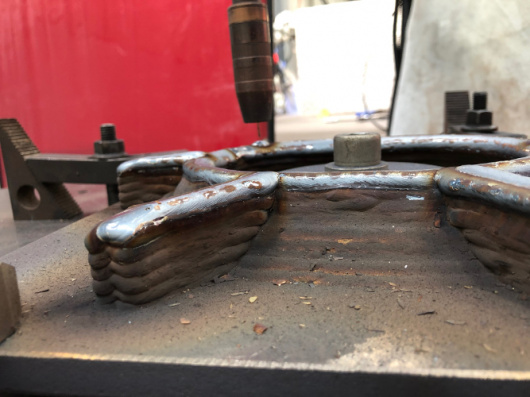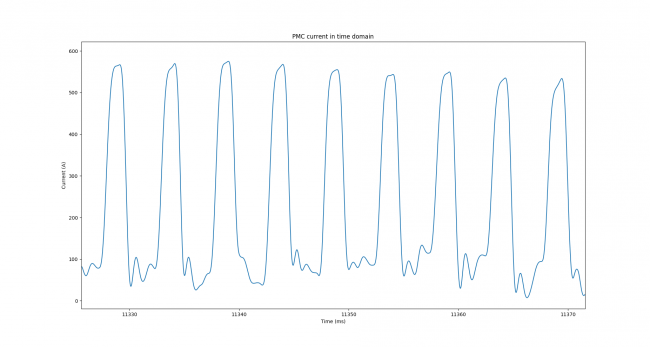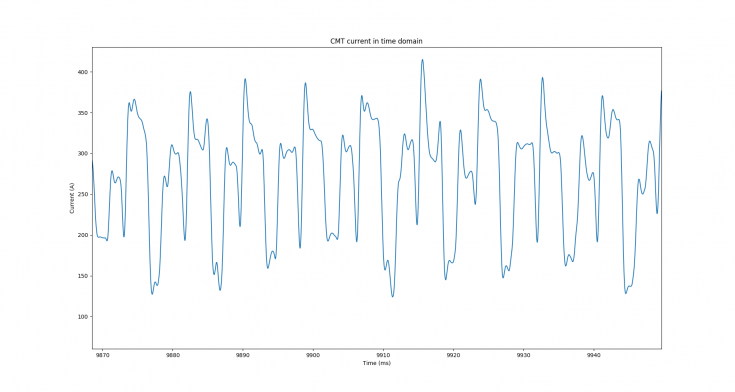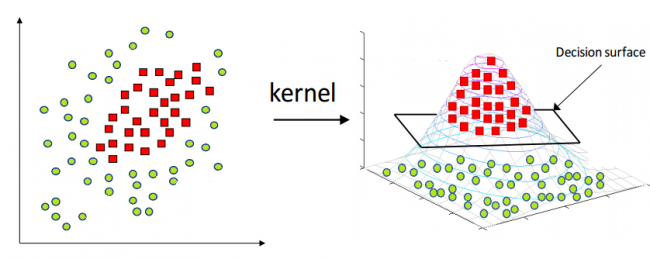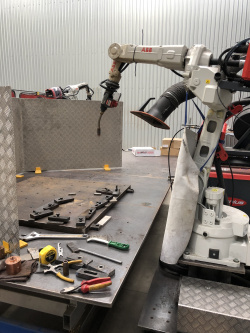Difference between revisions of "Projects:2019s2-20001 Using Machine Learning to Determine Deposit Height and Defects for Wire + Arc Additive Manufacture (3D printing)"
| Line 101: | Line 101: | ||
== Previous studies == | == Previous studies == | ||
| − | + | There are many researches into defect detection in GMAW process. The three most dominant analysis methods are spectroscopic analysis, acoustic analysis, and electrical signal analysis. | |
=== Spectroscopic analysis === | === Spectroscopic analysis === | ||
| + | In <ref name="spectroscopic_analysis">D. Bebiano and S. Alfaro, “A weld defects detection system based on a spectrometer,” Sensors, vol. 9, no. 4, pp. 2851–2861, 2009.</ref>, the authors captured the intensity of radiation emission of electric arc. It is obvious from figure 15 that good weld's intensity stays stable while defect one's is characterised by a sudden peak. Therefore, a threshold is set to detect the defect welds. | ||
| + | |||
| + | <div><ul> | ||
| + | <li style="display: inline-block;"> [[File:spectroscopic_analysis.png|thumb|400px|none|Figure 15: Spectroscopic analysis <ref name="spectroscopic_analysis"></ref>]] </li> | ||
| + | </ul></div> | ||
=== Acoustic analysis === | === Acoustic analysis === | ||
| + | With <ref name="acoustic_analysis">E. Cayo and S. C. Alfaro, “A non-intrusive GMA welding process quality monitoring system using acoustic sensing,” Sensors, vol. 9, no. 9, pp. 7150–7166, 2009.</ref>, the author discovered that arc ignition is characterised by a distinct sound and therefore it is possible to capture the frequency of ignition through acoustic sensors. A tolerance band was set and both ignition frequency and sound pressure level were used to monitor the quality of the weld. | ||
| + | |||
| + | <div><ul> | ||
| + | <li style="display: inline-block;"> [[File:acoustic_analysis.png|thumb|400px|none|Figure 16: Acoustic analysis <ref name="acoustic_analysis"></ref>]] </li> | ||
| + | </ul></div> | ||
=== Electrical signal analysis === | === Electrical signal analysis === | ||
| + | With <ref name="electrical_analysis_1">A. Sumesh, K. Rameshkumar, A. Raja, K. Mohandas, A. Santhakumari, and R. Shyambabu, “Establishing correlation between current and voltage signatures of the arc and weld defects in GMAW process,” Arabian Journal for Science and Engineering, vol. 42, no. 11, pp. 4649–4665, 2017.</ref>, the author plot the probability density distribution of voltage signal and discovered that the stable weld's signal concentrate in one region while unstable signal spread out. While in the paper, the authors did not developed a monitoring method using their findings, it shows that there is a significant differences between stable and unstable weld's electrical signature. | ||
| + | |||
| + | <div><ul> | ||
| + | <li style="display: inline-block;"> [[File:Electrical analysis pdd.png|thumb|400px|none|Figure 16: Voltage PDD <ref name="electrical_analysis_1"></ref>]] </li> | ||
| + | </ul></div> | ||
| + | |||
| + | In <ref name="electrical_analysis_2">S. Simpson, “Signature images for arc welding fault detection,” Science and Technology of Welding and Joining, vol. 12, no. 6, pp. 481–486, 2007.</ref>, the authors shows that by plotting the signature image of voltage and current scatter plot, both arcing and short-circuiting region's signature image can notify a defects welds. | ||
== Experiment setup == | == Experiment setup == | ||
Revision as of 20:57, 6 October 2019
Abstract here
Contents
Introduction
3D printing is an emerging technology that has the potential to significantly reduce material usage through the production of near net-shape parts. Many of the systems for 3D printing are based on lasers and powders; however the deposition rate with such systems is very low making the production of large-scale parts difficult. AML Technologies specialises in the use of Wire + Arc Additive Manufacture (WAAM) where deposition is based on arc welding processes and the deposition rates are an order of magnitude greater. When building 3D printed parts, even a relatively small layer height error of only 0.1 mm can produce large build height errors when multiplied across the many layers of a typical build. This can make path planning difficult, so in-process layer height measurement is an essential building block of any production 3D printing system. A variety of techniques can be used for monitoring the layer height including laser scanners, and arc monitoring. It is the latter technique that will be explored in this project due to its robustness, and low cost of implementation – it only requires the measurement of arc current and voltage. Furthermore, it can potentially be used to detect defects by identifying waveform irregularities.
Project team
Project students
- Anh Tran
- Nhat Nguyen
Supervisors
- Dr. Brian Ng
- Dr. Paul Colegrove (AML3D)
Objectives
The objective of this project is to increase the efficiency of the manufacture process at AML3D. In order to do so, the team will investigate into the possibility of automating and optimising the quality control processes. The two quality control processes that are currently being implemented at AML3D are measuring layer height using laser sensors, and human supervision for detecting defects. These processes add overhead into production time and usage of human resource, which is not desired. To achieve the goal, it is expected that machine learning methods will be used extensively to analyse the electrical signatures of the weld process.
Background
Wire Arc Additive Manufacturing
Wire and Arc Additive Manufacturing (WAAM) is a type of additive manufacturing that uses electric arc as the heat source and material wire to feed the manufacture process [1]. WAAM has been investigated since the 1990s [1], but only recently that it received more attention from the manufacture world.
Its significant comes from the ability to manufacture complex model with less time and less material. Figure 1a and 1b show real parts that was manufactured by AML3D. Such custom made parts might takes months before be ready to be shipped, but with WAAM, the production time can reduce down to weeks. Currently, the industries that benefit the most from WAAM are maritime and aerospace.
Similar to other additive manufacture methods, WAAM achieves such results by sliding the models into multiple layers, and then build the model layer by layer. The movement control is normally handled by a robotic arm (AML3D uses ABB's Arc Welder robot), and the welding path is generated by a Computer Aid Manufacture (CAM) software.
Currently at AML3D, the manufacture process for a part can take anywhere from days to weeks. However, the contact tip (where the welding gun deposits the wire) needs replacement every couple of hours. A worn contact tip such as figure 3 will lead to unstable weld and the this effect will propagate and accumulate through multiple layers. Such defects in the manufacture process will no doubt be financially taxing for AML3D. Apart from constant human supervision, another quality control process implemented at AML3D is height measurement of each layer, after the layer is built. This process is implemented to ensure the height of each layer is in the acceptable range (1-2mm). As mentioned before, these quality control processes are costing AML3D in term of time and finance. Our project will focus on replace them with a less time consuming, more automating process.
Gas metal arc welding
-
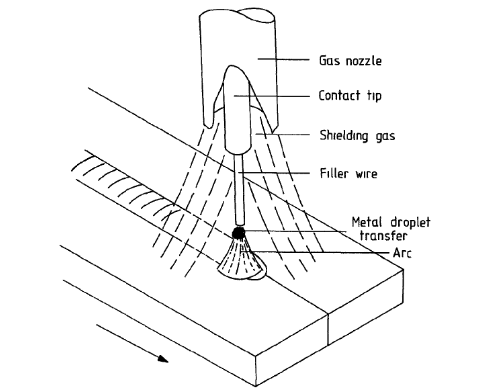 Figure 5: GMAW welding process [2]
Figure 5: GMAW welding process [2]
Gas metal arc welding (GMAW), or also known as metal inert gas (MIG), is the welding process used at AML3D for WAAM. Due to its high deposition rate and economic benefits, GMAW has became more popular. We will explore two variants of GMAW, which are Pulse Multi Control and Cold Metal Transfer. Both processes are developed by Fronius, an Austrian welding company. Note that it is not required to understand the welding physics to follow this wiki. The next two following sections' purpose is to highlight the high variability, high dynamic nature in welding.
Pulse Multi Control
Pulse Multi Control (PMC) welding is Fronius' modified Pulsed GMAW. The advantage of Pulsed GMAW is the ability to control the metal droplet transfer in welding. Note that from figure 7, the metal droplet is characterised by a downward slope of the current pulse. Figure 8 shows the current signal captured from experiments conducted at AML3D (PMC is used).
-
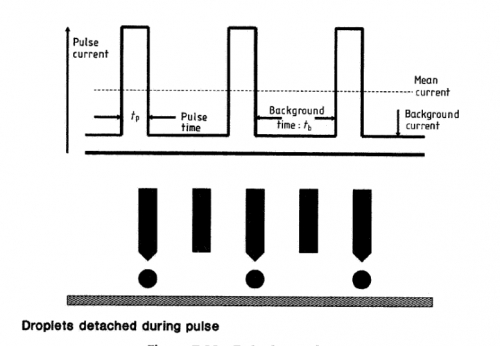 Figure 7: Relationship between pulse current and droplet transfer[2]
Figure 7: Relationship between pulse current and droplet transfer[2]
Cold Metal Transfer
Cold Metal Transfer (CMT) is a complex welding process, also developed by Fronius. By detecting a short circuit (mode C and D in figure 9), CMT can make adjustment such as retracting the welding material to cool down, and therefore create a smoother, more stable weld. The complexity of CMT can be seen in the current signal of the process (figure 10). Compare to PMC, CMT's signal has more variation during one signal period.
Machine Learning
Machine learning (or statistical learning) refer to a set of tools to give data scientists an insight into the data and make better decisions based on those information [3]. In this project, we will explore the capabilities of classical machine learning methods (i.e anything but Deep Learning) due to the limitation of our available data. By the time of writing this wiki, we have only explored Support Vector Machine.
Support Vector Machine
The main idea of Support Vector Machine (SVM) is to draw hyperplanes that best separate multiple classes of data. The original SVM judges best decision hyperplane based on the separation margin between data classes (figure 11). However, there are multiple variants of SVM, such as hard/soft margin SVM, Nu-SVM, One class SVM (to solve anomaly detection problem). In our project, we choose to use a soft margin implementation of SVM. The benefit of soft margin SVM (as oppose to hard margin SVM) is that by allowing some misclassifications, we get a wider margin and therefore the solution becomes more "generalise" (i.e work better with a new set of dataset that is independent from the training dataset).
-
 Figure 11: Separation margin [4]
Figure 11: Separation margin [4]
SVM algorithm makes use of Lagrange multiplier. Let's the linear model of the dataset be:
where ![]() denotes the feature space transformation, w denotes the weights and b denotes bias constant.
denotes the feature space transformation, w denotes the weights and b denotes bias constant.
Let ![]() be the input vector (where each index in the vector denotes a feature), and
be the input vector (where each index in the vector denotes a feature), and ![]() be the target (the class of input vector). It is showed that in order to maximise the (soft) margin, we will need to minimise the following:
be the target (the class of input vector). It is showed that in order to maximise the (soft) margin, we will need to minimise the following:
with subject to:
where N is the total number of training data, C is the regularisation parameter to control the effect of slack variable ![]() . A more visual presentation of slack variables can be found in figure 12.
. A more visual presentation of slack variables can be found in figure 12.
-
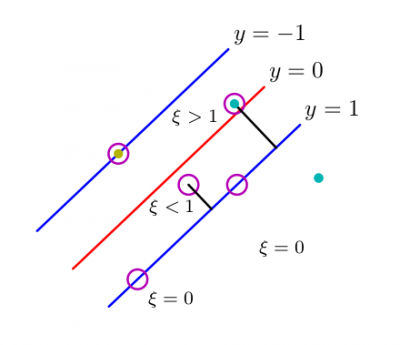 Figure 12: Slack variable [4]
Figure 12: Slack variable [4]
If we were to apply the Lagrangian method to solve the above minimisation problem, we can find the decision hyperplane for the SVM algorithm. However, we shall not discuss the solution here as it is not the main focus of the project.
Kernel tricks
Both figure 11 and 12 are of linearly separable cases for SVM. For dataset that is not easy to separate with a hyperplane in their original features space (such as figure 13), the data often get projected into a higher dimension space where it is easier to separate (figure 14). Such technique is called the Kernel Tricks. It is important to note that Kernel Tricks does not actually "map" the data from X dimension to Z dimension, but rather pairwise compare the similarity of the input space in Z dimension. However, we shall not dive too deep into this as it is not the main focus of the project.
-
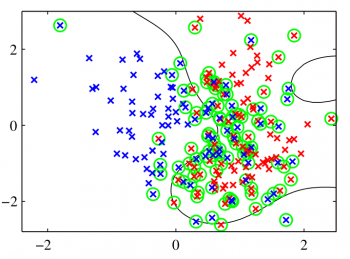 Figure 13: Nonseparable dataset [4]
Figure 13: Nonseparable dataset [4]
Previous studies
There are many researches into defect detection in GMAW process. The three most dominant analysis methods are spectroscopic analysis, acoustic analysis, and electrical signal analysis.
Spectroscopic analysis
In [5], the authors captured the intensity of radiation emission of electric arc. It is obvious from figure 15 that good weld's intensity stays stable while defect one's is characterised by a sudden peak. Therefore, a threshold is set to detect the defect welds.
-
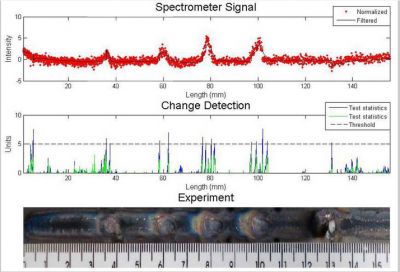 Figure 15: Spectroscopic analysis [5]
Figure 15: Spectroscopic analysis [5]
Acoustic analysis
With [6], the author discovered that arc ignition is characterised by a distinct sound and therefore it is possible to capture the frequency of ignition through acoustic sensors. A tolerance band was set and both ignition frequency and sound pressure level were used to monitor the quality of the weld.
-
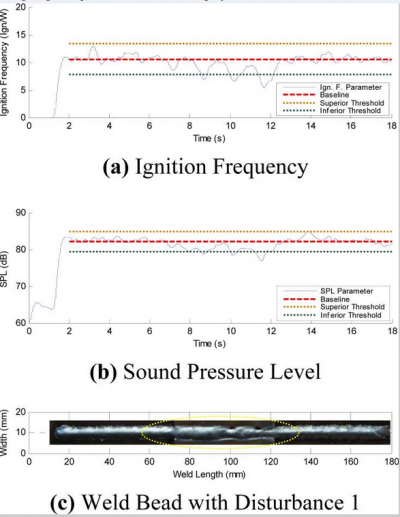 Figure 16: Acoustic analysis [6]
Figure 16: Acoustic analysis [6]
Electrical signal analysis
With [7], the author plot the probability density distribution of voltage signal and discovered that the stable weld's signal concentrate in one region while unstable signal spread out. While in the paper, the authors did not developed a monitoring method using their findings, it shows that there is a significant differences between stable and unstable weld's electrical signature.
-
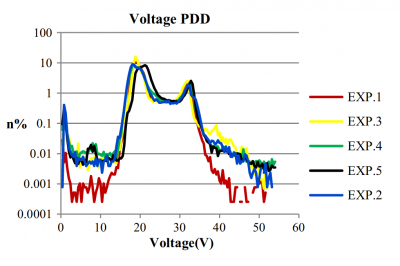 Figure 16: Voltage PDD [7]
Figure 16: Voltage PDD [7]
In [8], the authors shows that by plotting the signature image of voltage and current scatter plot, both arcing and short-circuiting region's signature image can notify a defects welds.
Experiment setup
The welding system uses TPS 320i C Pulse (figure 15a), produced by Fronius, to supply power, feed wire, and system cooling. For movement control of the welding torch, the system use ABB’s IRB 1520ID (figure 15b), which is a dedicated arc welding robot. The Data Acquisition device is NI's DAQ. Each channel (voltage and current) is sampled at 25kHz while the dominant frequency for voltage and current signal are around 130Hz (for CMT process) and 190Hz (for PMC process).
Statistical Analysis
Preprocessing
Power Spectrum Density
Support Vector Machine
Result discussion
Conclusion
Future work
References
- ↑ 1.0 1.1 S. W. Williams, F. Martina, A. C. Addison, J. Ding, G. Pardal & P. Colegrove (2016) Wire + Arc Additive Manufacturing, Materials Science and Technology, 32:7, 641-647, DOI: 10.1179/1743284715Y.0000000073
- ↑ 2.0 2.1 Norrish, J. (2006). Advanced welding processes. Elsevier.
- ↑ James, G., Witten, D., Hastie, T., & Tibshirani, R. (2013). An introduction to statistical learning (Vol. 112, p. 18). New York: Springer.
- ↑ 4.0 4.1 4.2 Bishop, C. M. (2006). Pattern recognition and machine learning. Springer.
- ↑ 5.0 5.1 D. Bebiano and S. Alfaro, “A weld defects detection system based on a spectrometer,” Sensors, vol. 9, no. 4, pp. 2851–2861, 2009.
- ↑ 6.0 6.1 E. Cayo and S. C. Alfaro, “A non-intrusive GMA welding process quality monitoring system using acoustic sensing,” Sensors, vol. 9, no. 9, pp. 7150–7166, 2009.
- ↑ 7.0 7.1 A. Sumesh, K. Rameshkumar, A. Raja, K. Mohandas, A. Santhakumari, and R. Shyambabu, “Establishing correlation between current and voltage signatures of the arc and weld defects in GMAW process,” Arabian Journal for Science and Engineering, vol. 42, no. 11, pp. 4649–4665, 2017.
- ↑ S. Simpson, “Signature images for arc welding fault detection,” Science and Technology of Welding and Joining, vol. 12, no. 6, pp. 481–486, 2007.


